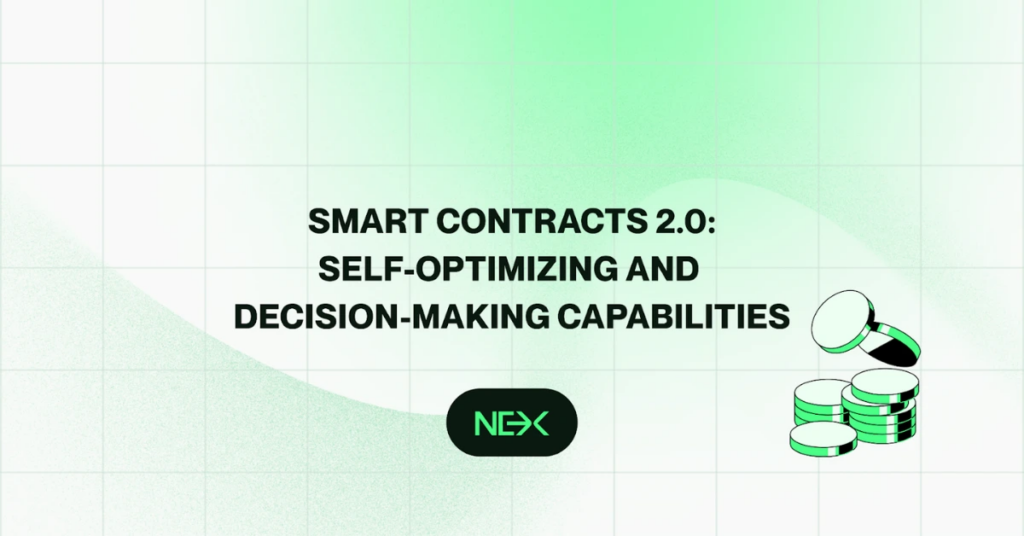Technological Innovations: Breakthroughs in Speed, AI, and Autonomous Decision-Making
Recently, blockchain technology company Nexchain officially launched Smart Contracts 2.0, marking a leap from “automated execution” to “cognitive decision-making” in smart contract technology. Its core innovations span three dimensions:

- Sub-second Execution Speed: By leveraging a parallel virtual machine architecture and an optimized consensus algorithm, Nexchain reduces smart contract processing time to 0.2 seconds—approximately 500 times faster than Ethereum’s EVM. This enables on‑chain operations in high‑frequency financial transactions and real‑time logistics scheduling to rival traditional centralized systems.
- AI-Driven Real‑Time Adjustment: The contracts integrate AI models such as LSTM neural networks to analyze off‑chain data (e.g., weather, market prices) in real time, dynamically adjusting execution logic. For example, a supply chain contract can automatically modify delivery routes based on traffic congestion data, reducing the risk of breaches.
- Autonomous Decision-Making Mechanism: By incorporating reinforcement learning algorithms, the contracts can generate new strategies beyond pre‑set rules. Test cases have shown that a DeFi lending protocol can autonomously adjust collateral ratio thresholds based on real‑time on‑chain liquidity data to lower liquidation risk.
Industry Applications: Practical Deployments from Finance to Logistics
Nexchain Smart Contracts 2.0 has already been commercially deployed in several fields:
- Finance: The Chicago Mercantile Exchange (CME) uses its derivatives contract system to complete price fluctuation analysis and hedging operations within one second, reducing slippage losses by 62%. In cross‑border payment scenarios, AI can predict exchange rates in real time and select the optimal settlement path, helping companies save 3%-5% in foreign exchange costs.
- Logistics & Supply Chain: An international shipping company reduced fuel costs by 12% by dynamically adjusting shipping routes; in fresh produce cold chain scenarios, contracts automatically trigger insurance claims based on temperature sensor data, compressing claim cycles from 7 days to 10 minutes, thereby significantly enhancing customer trust.
- DeFi: An AMM protocol developed in collaboration with Uniswap can dynamically adjust slippage parameters based on liquidity pool depth, reducing impermanent loss. Additionally, real estate trading contracts replace traditional notarization processes with on‑chain property verification, cutting legal review costs by 80%.
Potential Challenges: Technical Security and Regulatory Adaptation
Despite its promising prospects, Nexchain Smart Contracts 2.0 still face several challenges:
- Technical Security Risks: In February 2025, an anomaly in the testnet due to abnormal data input led to contract liquidation errors, exposing potential vulnerabilities of the “black box” nature of AI models. Furthermore, reliance on off‑chain data transmitted via oracles means that if nodes are attacked or data sources become distorted, the dynamic adjustment mechanism may fail.
- Regulatory Framework Lag: The EU’s MiCA regulation has yet to address the legal responsibilities of autonomous decision‑making contracts. Meanwhile, the U.S. SEC is examining whether such contracts should be classified as “automated investment advisors,” which could require operators to obtain specific licenses. The differing regulatory paces across countries may increase compliance costs for enterprises.
- Competitive Pressure within the Ecosystem: The Ethereum Foundation has announced an “AI Copilot” development suite to be launched in Q4 2025, directly challenging Nexchain’s technological advantages; moreover, only 35% of current Solidity developers express willingness to migrate to the new architecture, and ecosystem migration costs might delay widespread adoption.
Future Outlook: Cognitive Automation and Industry Restructuring
The launch of Nexchain Smart Contracts 2.0 heralds the evolution of blockchain technology into a “cognitive automation” phase. If its model of integrating AI with distributed ledgers is validated by the market, it could reduce global enterprise operating costs by $120 billion by 2026, particularly in supply chain finance and green energy trading, spawning new business models.
However, the key to success lies in balancing technological innovation with risk control. Developers must enhance the interpretability of AI models, regulators should expedite the formulation of legal frameworks suited for dynamic contracts, and enterprises must assess migration costs versus benefits. When technology, policy, and the ecosystem come together, Smart Contracts 2.0 may become the cornerstone for reconstructing trust in business.




